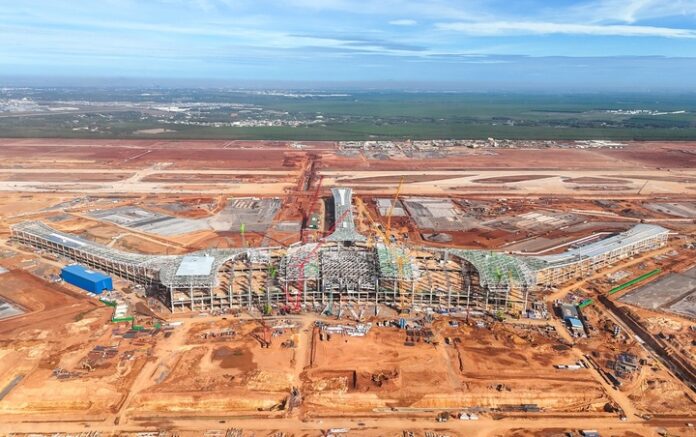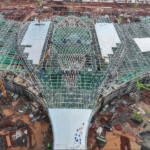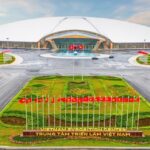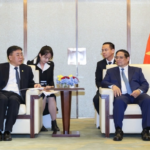The “Aerotropolis” Model: Integrating Airport and Urban Development
On June 27, at the seminar “Promoting Connectivity between Long Thanh and Ho Chi Minh City”, speakers shared their insights on the development of Long Thanh, Dong Nai. The vision is to transform this area into a modern aerotropolis, seamlessly integrating the international airport with surrounding residential, industrial, logistics, commercial, and service areas.
However, speakers highlighted the importance of efficient and synchronized connectivity. If not well-executed, the Long Thanh International Airport risks falling short of its potential and merely serving as a basic transportation hub.

Long Thanh is envisioned to become a modern aerotropolis. (Photo: Luong Y)
PGS.TS Tran Quang Phu, Vice Principal of Ho Chi Minh City University of Transport, emphasized that the “aerotropolis” model is a global trend. It involves not just constructing a modern airport but also synchronously planning and developing surrounding residential, industrial, logistics, commercial, and service areas. This is complemented by a multimodal transportation network, including highways, metro lines, railways, and bus rapid transit systems.
With this transformation, the airport becomes a powerful catalyst for economic growth, positively impacting the entire region.
“Currently, the connectivity between Long Thanh and Ho Chi Minh City is limited, relying mainly on the Ho Chi Minh City-Long Thanh-Dau Giay Highway, National Highway 51, and National Highway 1. While projects such as the Ring Roads 2, 3, and 4, and the Ben Luc-Long Thanh and Bien Hoa-Vung Tau highways are in the works, their implementation progress will be crucial to the success of this connectivity equation,”
said Mr. Phu.
He cautioned that if infrastructure development lags or is fragmented, Long Thanh may struggle to become a regional growth driver and instead remain solely a transportation hub.
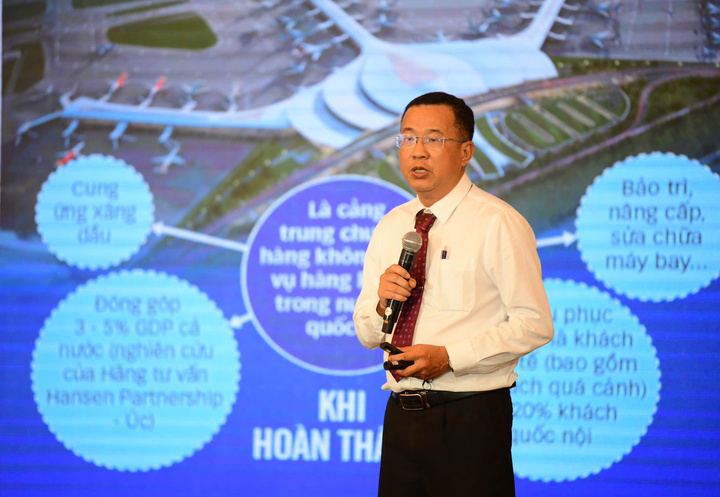
PGS.TS Tran Quang Phu, Vice Principal of Ho Chi Minh City University of Transport. (Photo: Quang Dinh)
Mr. Phu cited examples of successful international airports, such as Incheon-Seoul in South Korea, which boasts a dedicated 36-km highway, the Seoul metro line, the high-speed Airport Express (AREX) train, and BRT bus rapid transit with color-coded lines. These integrated transportation options provide seamless travel experiences and optimize regional connectivity, making the airport a powerful economic and urban development catalyst.
In the Netherlands, Schiphol Airport serves not just as an aviation gateway but also as an international hub for transportation, logistics, and trade. It offers direct rail connections to Brussels and Paris within 2-4 hours, an extensive metro tramway network, and a public bike-sharing system, OV-fiets.
Additionally, the nearby port of Rotterdam and its canal system ensure smooth freight transportation. This integrated model has allowed Schiphol Airport to attract FDI, create hundreds of thousands of jobs, and significantly contribute to the region’s GDP, beyond just passenger transportation.
According to experts, to compete with airports like Changi in Singapore or Suvarnabhumi in Thailand, Long Thanh Airport must develop synchronized infrastructure, including highways, ring roads, metro lines, and railways connecting Ho Chi Minh City, Bien Hoa, Binh Duong, and Ba Ria-Vung Tau.
Simultaneously, developing modern satellite towns can help alleviate population pressure on Ho Chi Minh City while boosting logistics, industry, trade, and services.
Tackling Infrastructure and Institutional Challenges
Mr. Truong Minh Huy Vu, Director of the Ho Chi Minh City Institute for Development Research, noted that from July 1, the Southeast region will essentially comprise three core localities: Ho Chi Minh City, Dong Nai, and Tay Ninh. Restructuring the development space is of utmost importance.
“We already have Ring Road 3, and this morning, the National Assembly approved Ring Road 4, shaping the inter-regional transportation system. The question now is how to redefine the development zones,”
Mr. Vu said.
He emphasized that the driving force is not just the airport but the aerotropolis, with an estimated investment of $40 billion. This includes connections to Tan Son Nhat Airport, Cai Mep- Thi Vai Port, Can Gio, and a comprehensive logistics and port system.
Mr. Vu highlighted the National Assembly’s approval of the master plan for the Ho Chi Minh City International Financial Center earlier in the day, which will attract investment and capital. He also drew attention to the proposal for an 8,300-hectare free trade area in Long Thanh.
“Where there is a free trade area linked to ports and airports, there will be a strong boost. The key is to design interconnected transportation, synchronously develop industrial parks, industrial belts, logistics, and digital data systems…”,
Mr. Vu shared.
Mr. Vu believes that the infrastructure challenge, particularly the road network leading to the airport, is significant. Ho Chi Minh City is reviewing its metro and railway network to connect to Long Thanh. He suggested considering rail connections to Binh Duong, Thu Dau Mot, or District 7 – Can Gio and focusing on key transportation axes.
He emphasized the need to pay special attention to institutional and procedural connectivity, streamlining processes to prevent large-scale projects from facing delays and cost overruns. Mr. Vu proposed extending the special mechanism of Ho Chi Minh City’s Resolution 98 to the entire Southeast region to accelerate the implementation of key infrastructure projects.
A Seamless Journey: Avoiding the 5-Hour Tan Son Nhat – Long Thanh Transit Travesty
“The Long Thanh International Airport risks falling short of its potential as a regional development catalyst if its infrastructure lags behind. A disjointed connection to Ho Chi Minh City could hinder the airport’s operations, relegating it to merely a transportation hub rather than a dynamic growth engine.”
Chinese Conglomerate Woos the Prime Minister with an Unprecedented Offer After a 20,000 Billion VND Project in Hanoi
The Chinese conglomerate is eager to expand its presence in Vietnam with a bold new vision. With a proven track record of success in the country, the company is now seeking to embark on even larger-scale projects, promising a transformative impact on the nation’s landscape.

